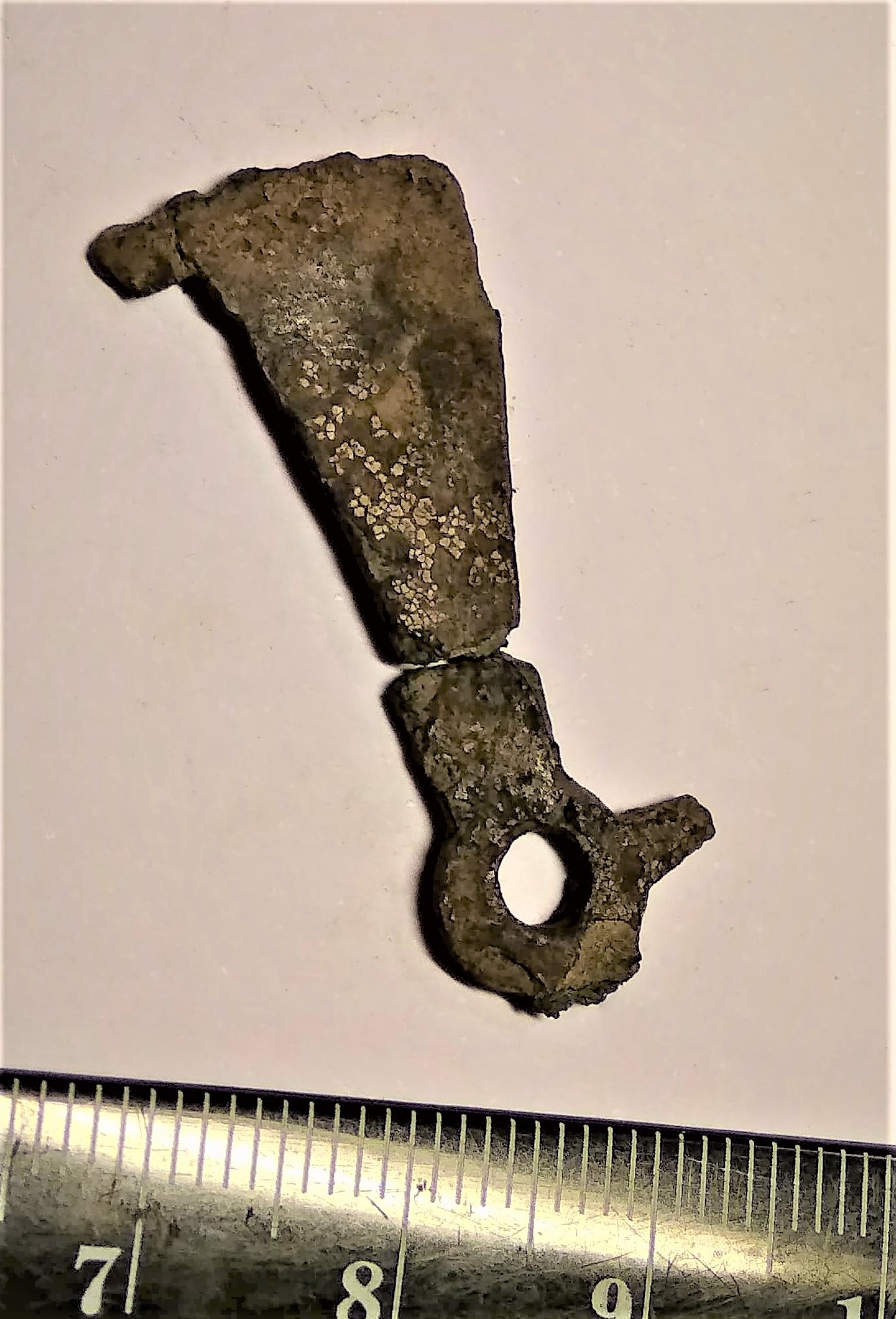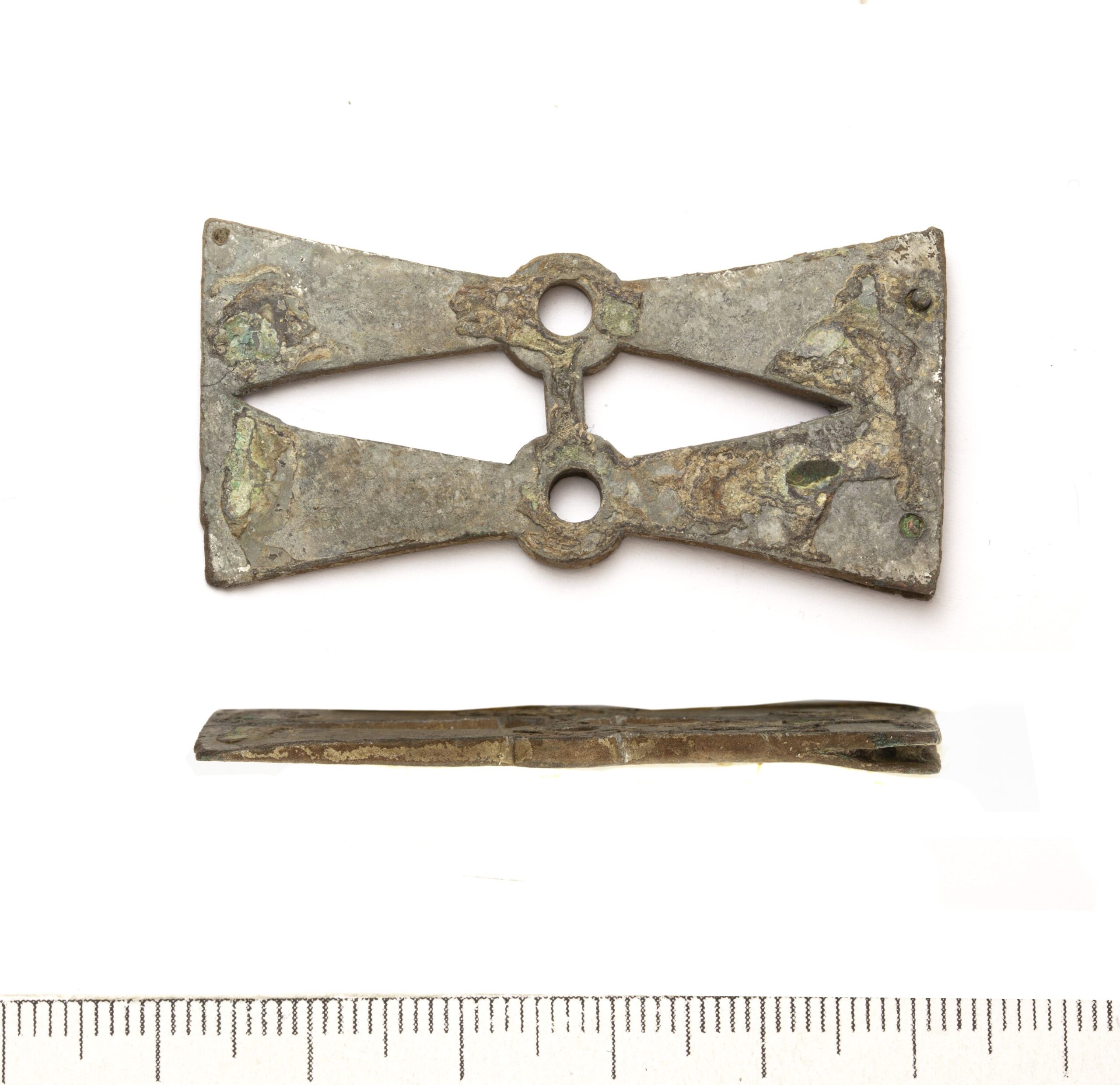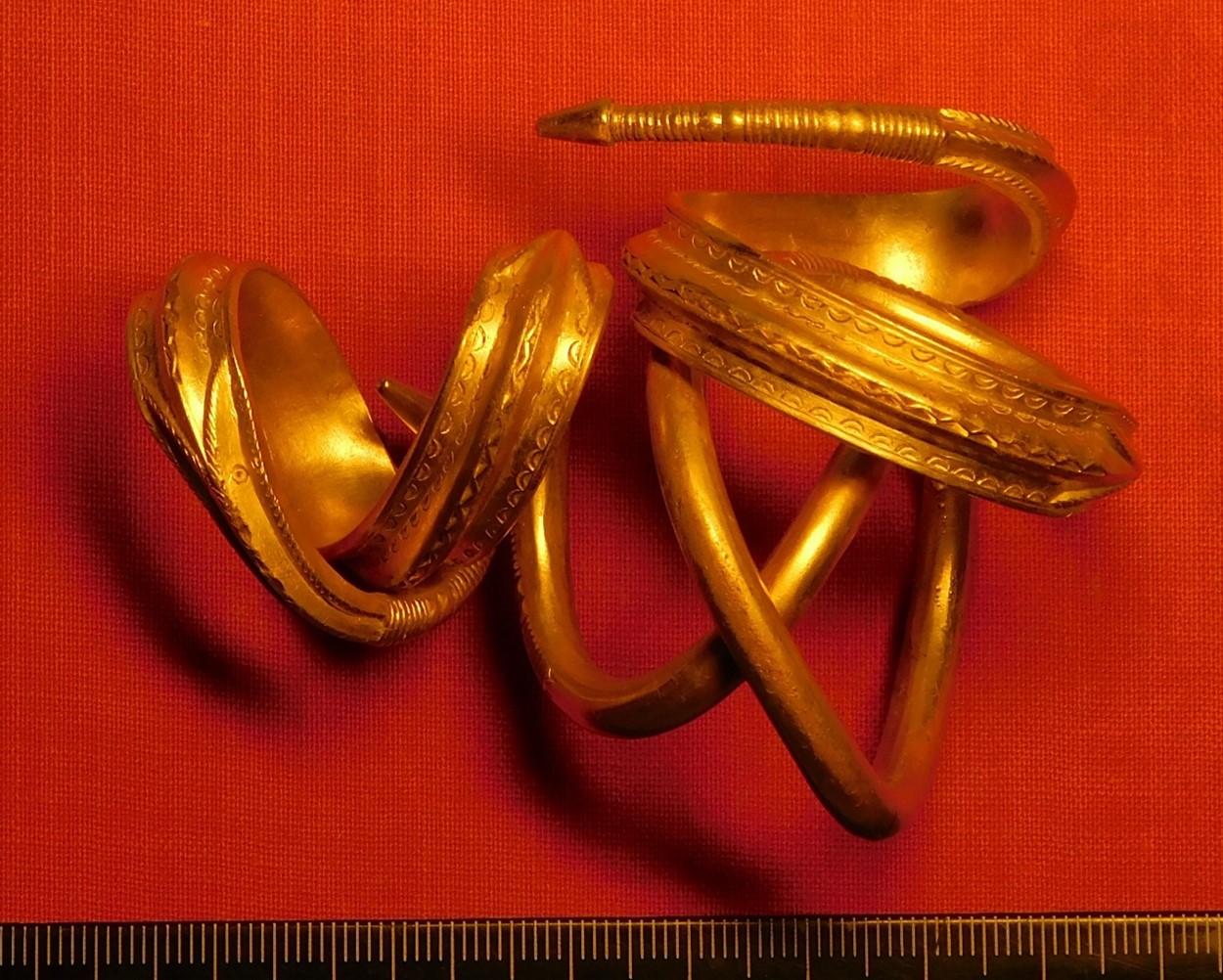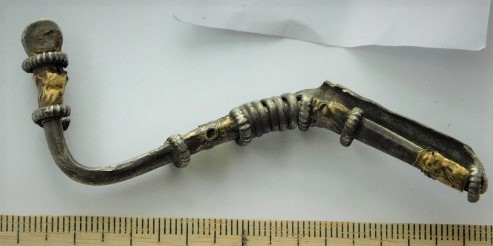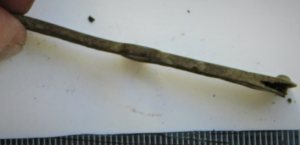Database
Our database is free to use for all history and archaeology enthusiasts. If you use our database, please do not forget to cite correctly:
Mägi, Marika; Palm, Piia Sandra. Archaeological Artefacts of Saaremaa. Foundation Osiliana / Tallinn University. Accessed: date.
The Osiliana Archaeological Database presents artefacts from Saaremaa and the surrounding small islands.
The database contains mainly Iron Age and Medieval finds that can be classified.
Undated metal or other pieces were generally excluded from the database.
Ceramics are represented by isolated examples.
The database is a work in progress and is constantly being updated.
Ure
Silver-plated propeller-shaped mount, bronze, two fragments. 1/4 of a double-propeller-shaped fitting. On one side a residue of a silver plating with an ornament is visible: a dotted line and a fine margin on the rounded part.
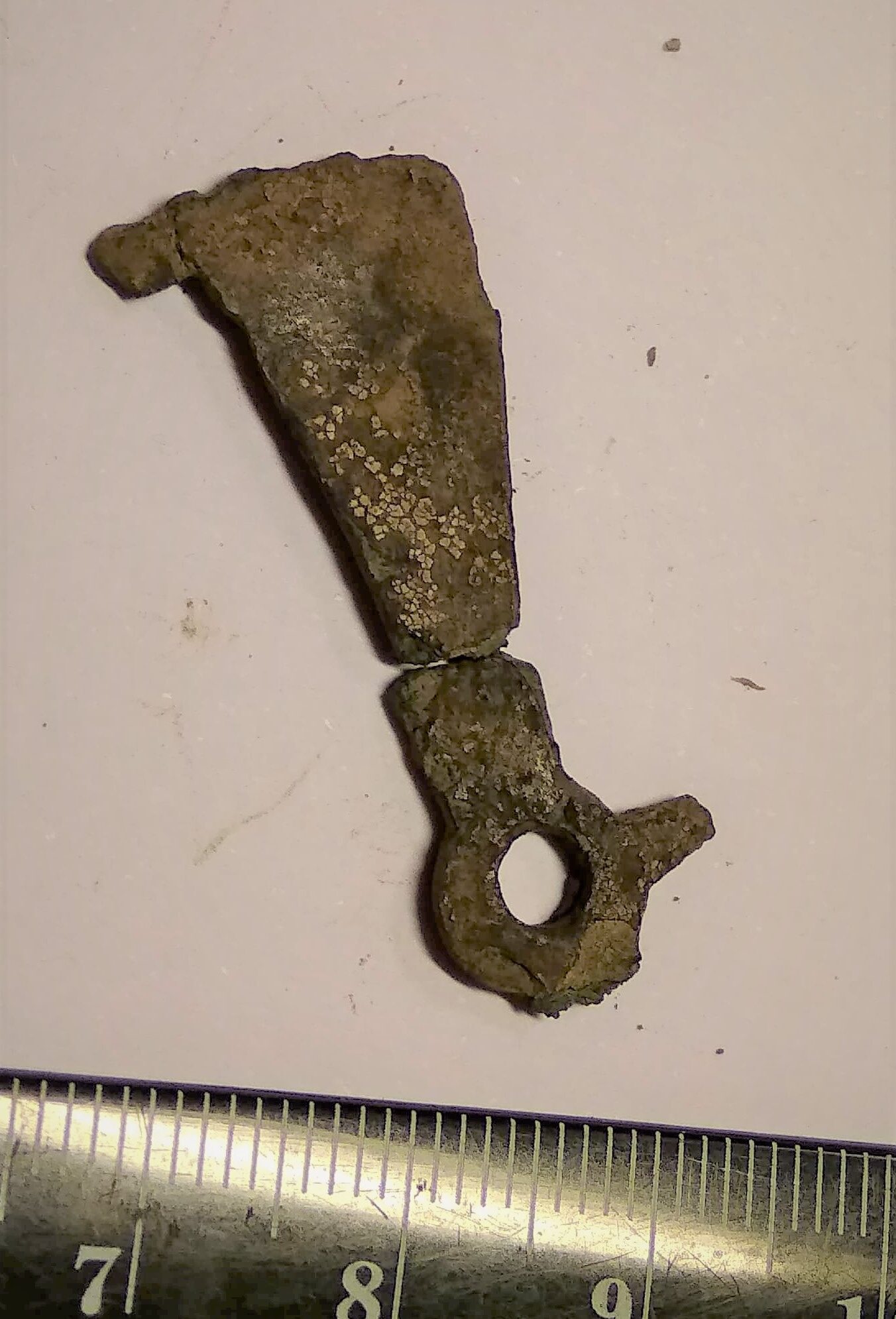
Silver-plated propeller-shaped mount, bronze, two fragments. 1/4 of a double-propeller-shaped fitting. On one side a residue of a silver plating with an ornament is visible: a dotted line and a fine margin on the rounded part.
See also Ure finds SM10862: 4, 33, 90, 117.
Such propeller-shaped fittings that hanged from a belt are normally considered Germanic, but were clearly influenced by Roman fashion. They decorate so-called ‘officers belts’ found near the pinetree-boat at Nydam sacrificial place in Denmark. Very similar belt ornaments, plated with silver and gold, are known from Ejsbølgård sacrifice, e. g. weapon offering D, dated 250-300 AD (Andersen 2003, 251-253).
Sword-belts decorated with propeller-shaped fittings have been also found in other sacrificial places, e.g. Skedemosse on the island of Öland (Monikander 2010, 46) and in South-Scandinavian elite graves, e. g. in a chamber grave at Lilla Jored (Sweden), Lærkenfeld (Denmark), or Sætrang (Norway) (Rau 2014).
In the Eastern Baltic, propeller-shaped mounts have been recorded so far in two sites: Kambja in Southern Estonia and Lejas-Kleperis in Northern Latvia (Moora 1929, pl. XXX: 14; 1938, 477). Five specimens are recorded in Ure. As suggested by the parallels mentioned above, they may originate from the same belt as the mount SM10862:9. The propeller-shaped mounts in Ure represent two different sizes, possibly indicating two sacrificed belts.
Belts decorated with propeller-shaped silver or silver-plated fittings are considered to belong to the commanders of the armies.
Literature:
Andersen, H. Chr. H. 2003. Nye undersøgelser i Ejsbøl mose. – Sejrens triumf. Norden i skyggen af det romerske imperium. Ed. by L. Jørgensen, B. Storgaard & L. Gebauer Thomsen. København, 246–256.
Jørgensen, E. & Petersen, P. V. 2003. Nydam mose – nye fund og iagttagelser. – Sejrens triumf. Norden i skyggen af det romerske imperium. Ed. by L. Jørgensen, B. Storgaard & L. Gebauer Thomsen. København, 258–294.
Monikander, A. 2010. Våld och vatten. Våtmarkskult vid Skedemosse under järnåldern. Stockholms Studies in Archaeology, 52. Stockholm. Read the article: here.
Moora, H. 1929. Die Eisenzeit in Lettland: bis etwa 500. N. Chr. Tafeln zum I. Teil. Tartu-Dorpat.
Moora, H. 1938. Die Eisenzeit in Lettland: bis etwa 500. N. Chr. II. Teil : Analyse. Tartu.
Mägi, M. 2021. Scandinavian chieftains in Saaremaa? Archaeological investigations in Ure, a probable Roman Period sacrificial place. – Archaeological Fieldwork in Estonia 2020, 73-90. Read the article: here.
Rau, A. 2014. Spätkaiserzeitlich-frühvölkerwanderungszeitliche Kammergräber der Sætrang-Lilla Jored-Gruppe. – Kammergräber im Barbaricum. Zu Einflüssen und Übergangsphänomenen von der vorrömischen Eisenzeit bis in die Völkerwanderungszeit. Ed. by N. Lau & A. Abegg-Wigg. Wachholtz, 145-166. Read the article: here.
Ure
Double-propeller-shaped mount, bronze. The upper part has been plated with silver. From one end it has been attached to a 2-mm-thick strap.
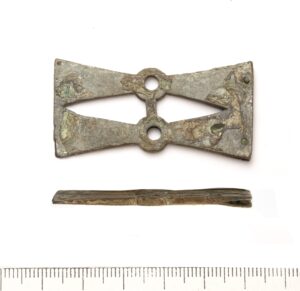
First photo: Jaana Ratas.
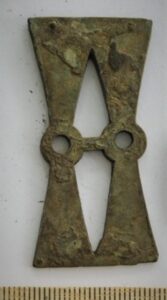
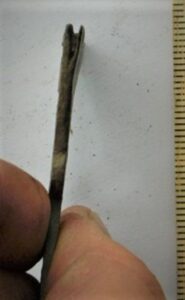
Parallels:
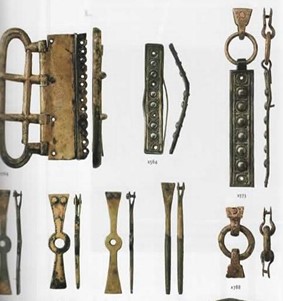
Mounts of sword belt from the weapon sacrifice Ejsbølgård D (Andersen 2003, 251, fig. 8. Photo Hadersel Museum/ Steen Hendriksen).

Reconstructed belt from Nydam fyretree boat (Jørgensen & Petersen 2003, 267, fig. 8; photo National Museum/ John Lee).
Double-propeller-shaped mount, bronze. The upper part has been plated with silver. From one end it has been attached to a 2-mm-thick strap.
See also Ure finds SM10862: 1, 33, 90, 117.
Such propeller-shaped fittings that hanged from a belt are normally considered Germanic, but were clearly influenced by Roman fashion. They decorate so-called ‘officers belts’ found near the pinetree-boat at Nydam sacrificial place in Denmark. Very similar belt ornaments, plated with silver and gold, are known from Ejsbølgård sacrifice, e. g. weapon offering D, dated 250-300 AD (Andersen 2003, 251-253).
Sword-belts decorated with propeller-shaped fittings have been also found in other sacrificial places, e.g. Skedemosse on the island of Öland (Monikander 2010, 46) and in South-Scandinavian elite graves, e. g. in a chamber grave at Lilla Jored (Sweden), Lærkenfeld (Denmark), or Sætrang (Norway) (Rau 2014).
In the Eastern Baltic, propeller-shaped mounts have been recorded so far in two sites: Kambja in Southern Estonia and Lejas-Kleperis in Northern Latvia (Moora 1929, pl. XXX: 14; 1938, 477). Five specimens are recorded in Ure. As suggested by the parallels mentioned above, they may originate from the same belt as the mount SM10862:9. The propeller-shaped mounts in Ure represent two different sizes, possibly indicating two sacrificed belts.
Belts decorated with propeller-shaped silver or silver-plated fittings are considered to belong to the commanders of the armies.
Literature:
Andersen, H. Chr. H. 2003. Nye undersøgelser i Ejsbøl mose. – Sejrens triumf. Norden i skyggen af det romerske imperium. Ed. by L. Jørgensen, B. Storgaard & L. Gebauer Thomsen. København, 246–256.
Jørgensen, E. & Petersen, P. V. 2003. Nydam mose – nye fund og iagttagelser. – Sejrens triumf. Norden i skyggen af det romerske imperium. Ed. by L. Jørgensen, B. Storgaard & L. Gebauer Thomsen. København, 258–294.
Monikander, A. 2010. Våld och vatten. Våtmarkskult vid Skedemosse under järnåldern. Stockholms Studies in Archaeology, 52. Stockholm. Read the article: here.
Moora, H. 1929. Die Eisenzeit in Lettland: bis etwa 500. N. Chr. Tafeln zum I. Teil. Tartu-Dorpat.
Moora, H. 1938. Die Eisenzeit in Lettland: bis etwa 500. N. Chr. II. Teil : Analyse. Tartu.
Mägi, M. 2021. Scandinavian chieftains in Saaremaa? Archaeological investigations in Ure, a probable Roman Period sacrificial place. – Archaeological Fieldwork in Estonia 2020, 73-90. Read the article: here.
Rau, A. 2014. Spätkaiserzeitlich-frühvölkerwanderungszeitliche Kammergräber der Sætrang-Lilla Jored-Gruppe. – Kammergräber im Barbaricum. Zu Einflüssen und Übergangsphänomenen von der vorrömischen Eisenzeit bis in die Völkerwanderungszeit. Ed. by N. Lau & A. Abegg-Wigg. Wachholtz, 145-166. Read the article: here.
Ure
Gold ring (spiral bracelet or neck ring rolled together), with the so-called serpent-head ends. Type C (Fernstål 2004), weight 175 g. Serpent-head is a general term for a variety of golden neck-rings, bracelets (including spiral ones), and rings in Northern Europe. Serpent-head rings were used in a fairly short period of time, from 210-330 AD. Many researchers consider these as symbols for the dukes or royal dynasties which would also explain the fact that they were used by both, men and women. Many of these sort of rings have been found from sacrificial places.
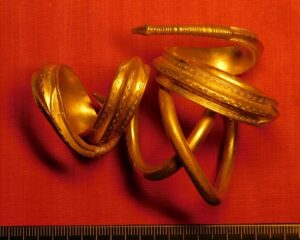
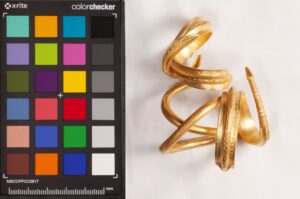
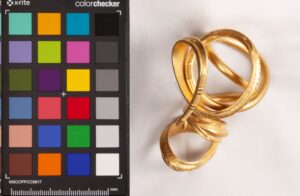
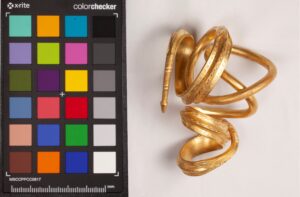
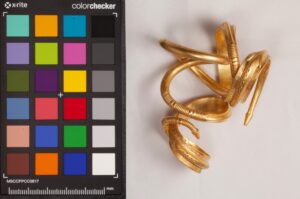
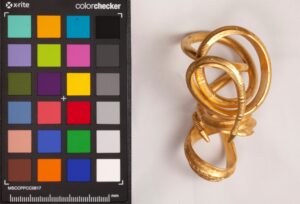
Last 5 photos: Jaana Ratas
Parallel
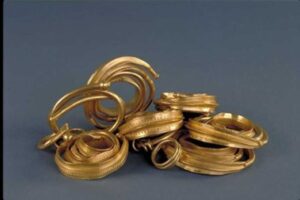
Gold rings from Skedemosse. Photo Ulf Bruxe, Statens Historiska Museum.
Gold ring (spiral bracelet or neck ring rolled together), with the so-called serpent-head ends. Type C (Fernstål 2004), weight 175 g. Serpent-head is a general term for a variety of golden neck-rings, bracelets (including spiral ones), and rings in Northern Europe. Serpent-head rings were used in a fairly short period of time, from 210-330 AD. Many researchers consider these as symbols for the dukes or royal dynasties which would also explain the fact that they were used by both, men and women. Many of these sort of rings have been found from sacrificial places (Törnblad 2017).
Serpent-head gold rings in Sweden were concentrated in Gotland and Öland, in Denmark in the area around Stevns in East-Zeeland, some have also been found in Southwestern Finland. Gotland and Öland have the highest ratio of neck-rings and bracelets of gold. Altogether there have been 62 gold neck-rings and bracelets found, 37 of them from Sweden, 12 from Denmark, and four from Southwestern Finland (Fernstål 2004; Törnblad 2017). The rings are commonly considered characteristic of Scandinavia and thus far such artefacts have not been found in the Eastern Baltic.
The most suitable parallel to the Ure complex is the sacrificial site of Skedemosse in Öland. Six gold rings found there are similarly to Ure deformed in shape so it is hard to define them either as spiral bracelets or neck-rings. Additionally, eleven propeller-shaped fittings, weapons, human (48) and animal sacrifices have been recorded in Skedemosse (Hagberg 1967).
Ure ring with its weight belongs amongst the largest ones of that type of artefacts in Northern Europe. Therefore, it can be suggested that the owner of this gold ring was part of the absolute top of the Scandinavian elite.
Literature:
Fernstål, L. 2004. Delar av en grav och glimtar av entid. Om yngre romersk järnålder, Tuna i Badelunda i Västmanland och personen i grav X. Doctoral thesis, Stockholm University, Faculty of Humanities, Department of Archaeology and Classical Studies. Stockholm. Read the article: here.
Hagberg, U. E. 1967. The Archaeology of Skedemosse. I–II. Kungl. Vitterhets Historie och Antikvitets Akademiens Handlingar. Monografien, 46: I–II. Stockholm.
Mägi, M. 2021. Scandinavian chieftains in Saaremaa? Archaeological investigations in Ure, a probable Roman Period sacrificial place. – Archaeological Fieldwork in Estonia 2020, 73-90. Read the article: here.
Rundkvist, M. 2021. Noble shape, humble metals. Bronze and silver shield-head and snake-head rings of Roman era Scandinavia. – Praehistorische Zeitschrift, vol. 96, no. 2, 2021, pp. 571-584. https://doi.org/10.1515/pz-2021-2020.
Törnblad, E. 2017. Ormhuvudringar – en analys av det sociala symbolspråket i relation till formgivning, fyndkontext och hantverk. Kandidatuppsats Arkeologi, Lund Universitet. Read the article: here.
Ure
Arc of a crossbow brooch, silver + gold + iron. The backward-shaped feet form the needle store which was wrapped at the end as wire for six rounds around the middle part of the arc. The head knob of the arc has a circular cross-section and in the hole of it a residue of an iron spiral axis. The brooch is ornamented in four places with two silver ring garnets which have a gold plate in-between. The gold plates have had embossed ornament. On the gold plate at the bottom of the foot, a small head of a bird and two diagonal stripes can be distinguished. The next one after this has diagonal embossed stripes and two birds. Another after that depicts the bird as well, flanked by a central ring and surrounding ovals of a flower. The uppermost plaque shows the image of a bird with a band of diagonal stripes below it. This is a typical Estonian brooch type, the only exception being the embossed ornamentation on the gold plaques as usually a reticulated pattern is used.

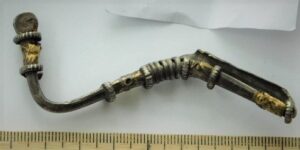
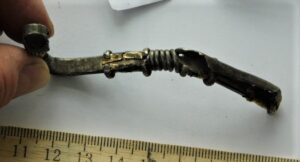
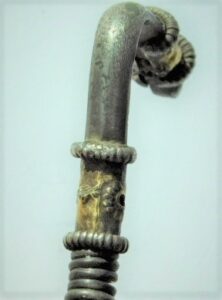
Arc of a crossbow brooch, silver + gold + iron. The backward-shaped feet form the needle store which was wrapped at the end as wire for six rounds around the middle part of the arc. The head knob of the arc has a circular cross-section and in the hole of it a residue of an iron spiral axis. The brooch is ornamented in four places with two silver ring garnets which have a gold plate in-between. The gold plates have had embossed ornament. On the gold plate at the bottom of the foot, a small head of a bird and two diagonal stripes can be distinguished. The next one after this has diagonal embossed stripes and two birds. Another after that depicts the bird as well, flanked by a central ring and surrounding ovals of a flower. The uppermost plaque shows the image of a bird with a band of diagonal stripes below it. This is a typical Estonian brooch type, the only exception being the embossed ornamentation on the gold plaques as usually a reticulated pattern is used. In Lithuanian Courland, such types of brooches were used from as early as the 2nd-3rd century (Tautavićius 1968, 141), but it seems more likely that the Ure specimen belongs to the 4th-5th centuries (Rohtla 2005, 126-127).
Literature:
Rohtla, M.-L. 2005. Crossbow fibula as a reflection of social status and relations. – Culture and Material Culture. – Interarchaeologia, 1. Ed. by V. Lang. Tartu – Riga – Vilnius, 121–145.
Tautavićius, A. (ed.) 1968. Lietuvos archeologiniai paminklai. Lietuvos pajūrio I-VII a. kapinynas. Vilnius.
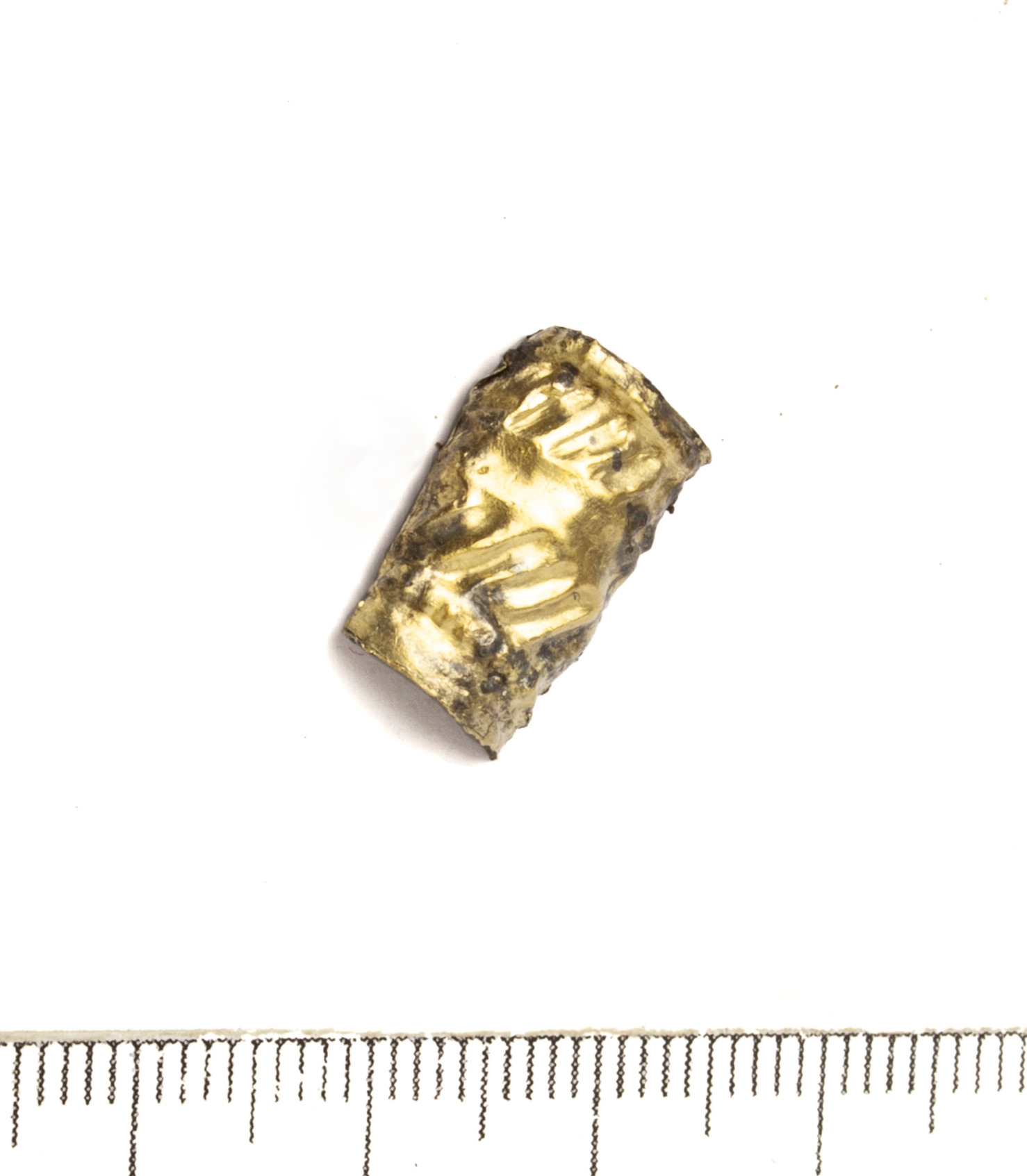
Ure
Piece of gold plate from a crossbow brooch (?), most probably from the arc. Embossed ornament with two zones of buttons and two zones of slashes between them. Ornament is similar to that of brooch nr SM10862:18.

Photo: Jaana Ratas.
Piece of gold plate from a crossbow brooch (?), most probably from the arc. Embossed ornament with two zones of buttons and two zones of slashes between them. Ornament is similar to that of brooch nr SM10862:18.
Ure
Propeller-shaped mount, bronze. It has been hanging from a belt, fixed with the broken part.
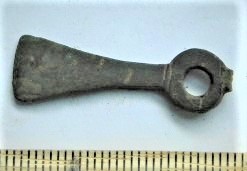
Parallels:

Mounts of sword belt from the weapon sacrifice Ejsbølgård D (Andersen 2003, 251, fig. 8. Photo Hadersel Museum/ Steen Hendriksen).

Reconstructed belt from Nydam fyretree boat (Jørgensen & Petersen 2003, 267, fig. 8; photo National Museum/ John Lee).
Propeller-shaped mount, bronze. It has been hanging from a belt, fixed with the broken part.
See also Ure finds SM10862: 1, 4, 90, 117.
Such propeller-shaped fittings that hanged from a belt are normally considered Germanic, but were clearly influenced by Roman fashion. They decorate so-called ‘officers belts’ found near the pinetree-boat at Nydam sacrificial place in Denmark. Very similar belt ornaments, plated with silver and gold, are known from Ejsbølgård sacrifice, e. g. weapon offering D, dated 250-300 AD (Andersen 2003, 251-253).
Sword-belts decorated with propeller-shaped fittings have been also found in other sacrificial places, e.g. Skedemosse on the island of Öland (Monikander 2010, 46) and in South-Scandinavian elite graves, e. g. in a chamber grave at Lilla Jored (Sweden), Lærkenfeld (Denmark), or Sætrang (Norway) (Rau 2014).
In the Eastern Baltic, propeller-shaped mounts have been recorded so far in two sites: Kambja in Southern Estonia and Lejas-Kleperis in Northern Latvia (Moora 1929, pl. XXX: 14; 1938, 477). Five specimens are recorded in Ure. As suggested by the parallels mentioned above, they may originate from the same belt as the mount SM10862:9. The propeller-shaped mounts in Ure represent two different sizes, possibly indicating two sacrificed belts.
Belts decorated with propeller-shaped silver or silver-plated fittings are considered to belong to the commanders of the armies.
Literature:
Andersen, H. Chr. H. 2003. Nye undersøgelser i Ejsbøl mose. – Sejrens triumf. Norden i skyggen af det romerske imperium. Ed. by L. Jørgensen, B. Storgaard & L. Gebauer Thomsen. København, 246–256.
Jørgensen, E. & Petersen, P. V. 2003. Nydam mose – nye fund og iagttagelser. – Sejrens triumf. Norden i skyggen af det romerske imperium. Ed. by L. Jørgensen, B. Storgaard & L. Gebauer Thomsen. København, 258–294.
Monikander, A. 2010. Våld och vatten. Våtmarkskult vid Skedemosse under järnåldern. Stockholms Studies in Archaeology, 52. Stockholm. Read the article: here.
Moora, H. 1929. Die Eisenzeit in Lettland: bis etwa 500. N. Chr. Tafeln zum I. Teil. Tartu-Dorpat.
Moora, H. 1938. Die Eisenzeit in Lettland: bis etwa 500. N. Chr. II. Teil : Analyse. Tartu.
Mägi, M. 2021. Scandinavian chieftains in Saaremaa? Archaeological investigations in Ure, a probable Roman Period sacrificial place. – Archaeological Fieldwork in Estonia 2020, 73-90. Read the article: here.
Rau, A. 2014. Spätkaiserzeitlich-frühvölkerwanderungszeitliche Kammergräber der Sætrang-Lilla Jored-Gruppe. – Kammergräber im Barbaricum. Zu Einflüssen und Übergangsphänomenen von der vorrömischen Eisenzeit bis in die Völkerwanderungszeit. Ed. by N. Lau & A. Abegg-Wigg. Wachholtz, 145-166. Read the article: here.
Ure
Crossbow brooch, bronze. The upper part is missing. The foot has been bent backward for a needle container and wrapped around the arch like a wire for four times. Underneath that and towards the foot of the arch are traces of gold plating.
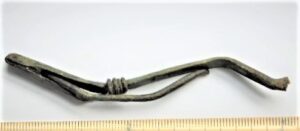
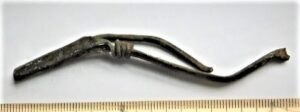

Crossbow brooch, bronze. The upper part is missing. The foot has been bent backward for a needle container and wrapped around the arch like a wire for four times. Underneath that and towards the foot of the arch are traces of gold plating. That type of brooches was common in Estonia mainly during the 2-3d century, but they can also be dated to the 4th-5th century (Randla 2005, 123 jj). In Courland, similar ones have been dated to 2-3rd centuries. (Tautaviśius 1968, 131-13; Griciuvienė 2009, 33, 46).
Literature:
Griciuvienė, E. (prepared by) 2009. Kuršiai. Genties kultūra laidosenos duomenimis. Baltų archeologijos paroda. Katalogas. The Curonians. Tribe Culture According to the Burial Data. Baltic Archaeological Exhibition. Catalogue. Vilnius –Riga.
Rohtla, M.-L. 2005. Crossbow fibula as a reflection of social status and relations. – Culture and Material Culture. Interarchaeologia, 1. Ed. by V. Lang. Tartu – Riga – Vilnius, 121–145.
Tautavićius, A. (ed.) 1968. Lietuvos archeologiniai paminklai. Lietuvos pajūrio I-VII a. kapinynas. Vilnius.
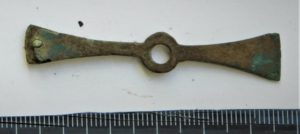
Parallels:

Mounts of sword belt from the weapon sacrifice Ejsbølgård D (Andersen 2003, 251, fig. 8. Photo Hadersel Museum/ Steen Hendriksen).

Reconstructed belt from Nydam fyretree boat (Jørgensen & Petersen 2003, 267, fig. 8; photo National Museum/ John Lee).
Propeller-shaped belt fitting, bronze.
See also Ure finds SM10862: 1, 4, 33, 117.
Such propeller-shaped fittings that hanged from a belt are normally considered Germanic, but were clearly influenced by Roman fashion. They decorate so-called ‘officers belts’ found near the pinetree-boat at Nydam sacrificial place in Denmark. Very similar belt ornaments, plated with silver and gold, are known from Ejsbølgård sacrifice, e. g. weapon offering D, dated 250-300 AD (Andersen 2003, 251-253).
Sword-belts decorated with propeller-shaped fittings have been also found in other sacrificial places, e.g. Skedemosse on the island of Öland (Monikander 2010, 46) and in South-Scandinavian elite graves, e. g. in a chamber grave at Lilla Jored (Sweden), Lærkenfeld (Denmark), or Sætrang (Norway) (Rau 2014).
In the Eastern Baltic, propeller-shaped mounts have been recorded so far in two sites: Kambja in Southern Estonia and Lejas-Kleperis in Northern Latvia (Moora 1929, pl. XXX: 14; 1938, 477). Five specimens are recorded in Ure. As suggested by the parallels mentioned above, they may originate from the same belt as the mount SM10862:9. The propeller-shaped mounts in Ure represent two different sizes, possibly indicating two sacrificed belts.
Belts decorated with propeller-shaped silver or silver-plated fittings are considered to belong to the commanders of the armies.
Literature:
Andersen, H. Chr. H. 2003. Nye undersøgelser i Ejsbøl mose. – Sejrens triumf. Norden i skyggen af det romerske imperium. Ed. by L. Jørgensen, B. Storgaard & L. Gebauer Thomsen. København, 246–256.
Jørgensen, E. & Petersen, P. V. 2003. Nydam mose – nye fund og iagttagelser. – Sejrens triumf. Norden i skyggen af det romerske imperium. Ed. by L. Jørgensen, B. Storgaard & L. Gebauer Thomsen. København, 258–294.
Monikander, A. 2010. Våld och vatten. Våtmarkskult vid Skedemosse under järnåldern. – Stockholms Studies in Archaeology, 52. Stockholm. Read the article: here.
Moora, H. 1929. Die Eisenzeit in Lettland: bis etwa 500. N. Chr. Tafeln zum I. Teil. Tartu-Dorpat.
Moora, H. 1938. Die Eisenzeit in Lettland: bis etwa 500. N. Chr. II. Teil : Analyse. Tartu.
Mägi, M. 2021. Scandinavian chieftains in Saaremaa? Archaeological investigations in Ure, a probable Roman Period sacrificial place. – Archaeological Fieldwork in Estonia 2020, 73-90. Read the article: here.
Rau, A. 2014. Spätkaiserzeitlich-frühvölkerwanderungszeitliche Kammergräber der Sætrang-Lilla Jored-Gruppe. – Kammergräber im Barbaricum. Zu Einflüssen und Übergangsphänomenen von der vorrömischen Eisenzeit bis in die Völkerwanderungszeit. Ed. by N. Lau & A. Abegg-Wigg. Wachholtz, 145-166. Read the article: here.
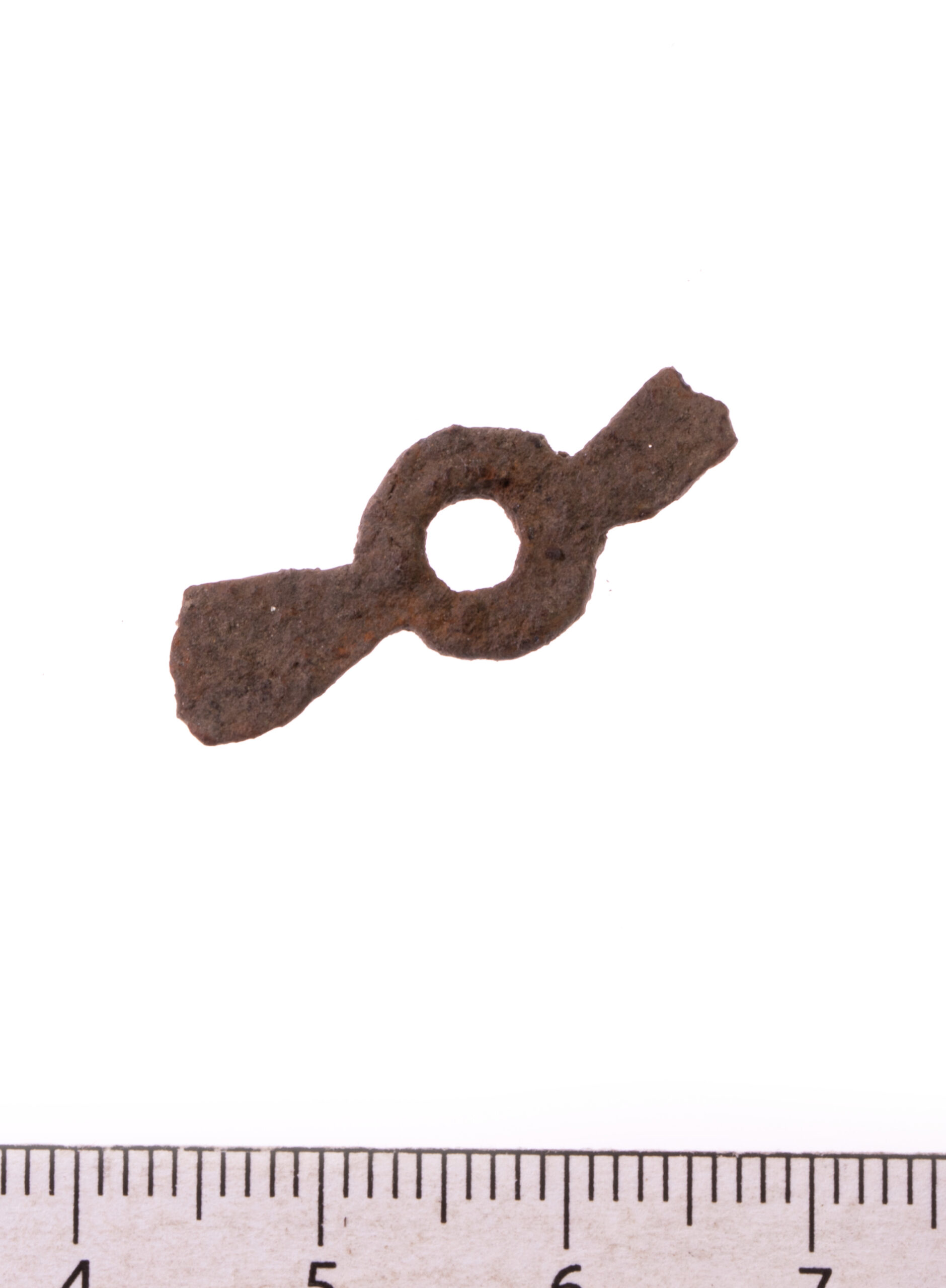
Ure
Fragment of propeller-shaped belt fitting, iron.
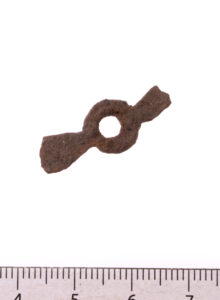
Photo: Jaana Ratas.
Fragment of propeller-shaped belt fitting, iron. Middle part.
See also Ure finds SM10862: 1, 4, 33, 117.
Such propeller-shaped fittings that hanged from a belt are normally considered Germanic, but were clearly influenced by Roman fashion. They decorate so-called ‘officers belts’ found near the pinetree-boat at Nydam sacrificial place in Denmark. Very similar belt ornaments, plated with silver and gold, are known from Ejsbølgård sacrifice, e. g. weapon offering D, dated 250-300 AD (Andersen 2003, 251-253).
Sword-belts decorated with propeller-shaped fittings have been also found in other sacrificial places, e.g. Skedemosse on the island of Öland (Monikander 2010, 46) and in South-Scandinavian elite graves, e. g. in a chamber grave at Lilla Jored (Sweden), Lærkenfeld (Denmark), or Sætrang (Norway) (Rau 2014).
In the Eastern Baltic, propeller-shaped mounts have been recorded so far in two sites: Kambja in Southern Estonia and Lejas-Kleperis in Northern Latvia (Moora 1929, pl. XXX: 14; 1938, 477). Five specimens are recorded in Ure. As suggested by the parallels mentioned above, they may originate from the same belt as the mount SM10862:9. The propeller-shaped mounts in Ure represent two different sizes, possibly indicating two sacrificed belts.
Literature:
Andersen, H. Chr. H. 2003. Nye undersøgelser i Ejsbøl mose. – Sejrens triumf. Norden i skyggen af det romerske imperium. Ed. by L. Jørgensen, B. Storgaard & L. Gebauer Thomsen. København, 246–256.
Jørgensen, E. & Petersen, P. V. 2003. Nydam mose – nye fund og iagttagelser. – Sejrens triumf. Norden i skyggen af det romerske imperium. Ed. by L. Jørgensen, B. Storgaard & L. Gebauer Thomsen. København, 258–294.
Monikander, A. 2010. Våld och vatten. Våtmarkskult vid Skedemosse under järnåldern. – Stockholms Studies in Archaeology, 52. Stockholm. Read the article: here.
Moora, H. 1929. Die Eisenzeit in Lettland: bis etwa 500. N. Chr. Tafeln zum I. Teil. Tartu-Dorpat.
Moora, H. 1938. Die Eisenzeit in Lettland: bis etwa 500. N. Chr. II. Teil : Analyse. Tartu.
Mägi, M. 2021. Scandinavian chieftains in Saaremaa? Archaeological investigations in Ure, a probable Roman Period sacrificial place. – Archaeological Fieldwork in Estonia 2020, 73-90. Read the article: here.
Rau, A. 2014. Spätkaiserzeitlich-frühvölkerwanderungszeitliche Kammergräber der Sætrang-Lilla Jored-Gruppe. – Kammergräber im Barbaricum. Zu Einflüssen und Übergangsphänomenen von der vorrömischen Eisenzeit bis in die Völkerwanderungszeit. Ed. by N. Lau & A. Abegg-Wigg. Wachholtz, 145-166. Read the article: here.
The negative value refers to time Before Christ.

